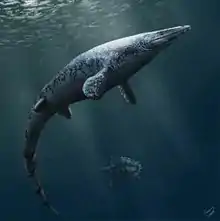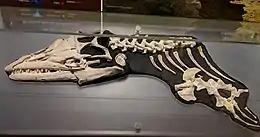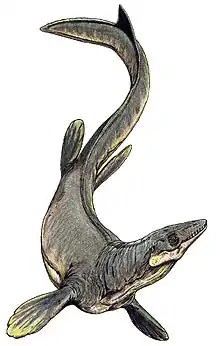Angolasaurus
Angolasaurus ("Angola lizard") is an extinct genus of mosasaur. Definite remains from this genus have been recovered from the Turonian and Coniacian of Angola,[1] and possibly the Coniacian of the United States, the Turonian of Brazil,[2] and the Maastrichtian of Niger.[3][4] While at one point considered a species of Platecarpus,[5] recent phylogenetic analyses have placed it between the (then) plioplatecarpines Ectenosaurus and Selmasaurus, maintaining a basal position within the plioplatecarpinae.[6]
| Angolasaurus | |
|---|---|
 | |
| Illustration of the skull of Angolasaurus | |
| Scientific classification | |
| Domain: | Eukaryota |
| Kingdom: | Animalia |
| Phylum: | Chordata |
| Class: | Reptilia |
| Order: | Squamata |
| Superfamily: | †Mosasauroidea |
| Family: | †Mosasauridae |
| Subfamily: | †Plioplatecarpinae |
| Genus: | †Angolasaurus Telles-Antunes, 1964 |
| Species: | †A. bocagei |
| Binomial name | |
| †Angolasaurus bocagei Telles-Antunes, 1964 | |
| Synonyms | |
| |
Its wide geographic range make it the one of the only Turonian mosasaurs with a transatlantic range.[2]
Description

Angolasaurus was a small mosasaur, with a skull length estimated at 40 centimetres (1.3 ft),[7] suggesting a possible total length of about 4 meters (13 feet) based on the ratio provided by Russell (1967).[8] An individual of such size would have weighed 200 kg (440 lb).[9] It shared much of a body plan with its relative Platecarpus, but with a slightly longer skull relative to body length.[5] Its skull housed 11 maxillary teeth, 4 premaxillary teeth, and 12 dentary teeth. The phylogenetic relationship of Angolasaurus indicates that individuals of this genus possessed a tail fluke, more forward-lying nostrils,[10] and keeled scales for hydrodynamic efficiency.[11]
Due to declining sea temperatures in the area that Angolasaurus inhabited, as well as the later Bientiaba locality, it has been hypothesized that it and the other mosasaurs inhabiting its region may have had an increased coverage of dark patterning on its dorsal surface to aid in thermoregulation.[12]
History of discovery
First named in 1964 by Miguel Telles Antunes on the basis of a partial skull and skeleton, Angolasaurus was reassigned in 1994 to the genus Platecarpus.[5] This placement was subsequently struck down in studies in 2005, which nested it within the plioplatecarpinae.[1] Fieldwork between 2005 and 2009 recovered at least two new Angolasaurus skeletons. One new skull as well as the type skull were CT scanned to reveal intricate details of the interior braincase that allowed for a more concrete placement within the plioplatecarpinae.[2] The most recent major phylogenetic analysis conducted on the mosasauridae placed Angolasaurus as basal to the clade composed of the russellosaurine subfamilies Tylosaurinae and Plioplatecarpinae, and part of neither.[13]
In 2007, two individuals from the Eagle Ford Formation of Texas were described as belonging to the genus Angolasaurus, one of which preserved part of the hyoid apparatus. The same abstract assigned two teeth previously assigned to Platecarpus to Angolasaurus. These teeth came from the Sergipe Basin of Brazil, and are virtually indistinguishable from those found in the holotype of Angolasaurus bocagei. These discoveries made Angolasaurus the first known Turonian mosasaur genus with a transatlantic distribution.[2]
Paleoecology

Angola
Angolasaurus bocagei, recovered only from the Itombe Formation, shared its habitat with the tylosaurine species Tylosaurus (formerly Mosasaurus) iembeensis and the durophagous shallow-water turtle Angolachelys. Indeterminate halisaurine and plesiosaur remains have also been recovered from this region. Terrestrial fauna consisted solely of the sauropod Angolatitan.[14]
Niger
Known from the Dukamaje Formation on the basis of a few vertebrae of varying ontogenetic stages, Angolasaurus coexisted here with fellow plioplatecarpine genera Platecarpus and Plioplatecarpus, the globidensine genus Igdamanosaurus, the halisaurine genus Halisaurus, the mosasaurine genus Mosasaurus, and the mosasaurid genus Goronyosaurus.[14]
United States
Angolasaurus is known from the Eagle Ford Formation of Texas. Other Turonian aquatic reptiles from the Eagle Ford Formation include the plesiosaurs Polyptychodon, Libonectes, Cimoliasaurus, and Plesiosaurus, and the mosasaur Clidastes. Indeterminate mosasaur and plesiosaur remains are also known from here.[15]
References
- Jacobs; et al. (2006). "THE OCCURRENCE AND GEOLOGICAL SETTING OF CRETACEOUS DINOSAURS, MOSASAURS, PLESIOSAURS, AND TURTLES FROM ANGOLA" (PDF). Paleont. Soc. Korea. 22. Archived from the original (PDF) on 2017-03-28. Retrieved 2017-03-28.
- Polcyn, M.; Lindgren, J.; Bell, G.L. Jr. (2007). "The possible occurrence of Angolasaurus in the Turonian of North and South America". In Everhart, M.J. (ed.). Abstract Booklet of the Second Mosasaur Meeting (PDF). Hays, Kansas. p. 21.
{{cite book}}: CS1 maint: location missing publisher (link) - Lingham-Soliar, Theagarten (1991). "Mosasaurs from the upper Cretaceous of Niger". Palaeontology. 34: 653–670.
- Moody, R. T. J and Suttcliffe, P. T. C. (1991). The Cretaceous deposits of the Iullemmeden Basin of Niger, central West Africa. Cretaceous Research 12:137-157
- Lingham-Soliar, Theagartan (1994). "The mosasaur "Angolasaurus" bocagei (Reptilia: Mosasauridae) from the Turonian of Angola re-interpreted as the earliest member of the genus Platecarpus". Paläontologische Zeitschrift. 68 (1–2). doi:10.1007/bf02989445. S2CID 128963124.
- Konishi, Takuya; Caldwell, Michaell (2011). "Two new plioplatecarpine (Squamata, Mosasauridae) genera from the Upper Cretaceous of North America, and a global phylogenetic analysis of plioplatecarpines". Journal of Vertebrate Paleontology. 31 (4): 754–783. Bibcode:2011JVPal..31..754K. doi:10.1080/02724634.2011.579023. S2CID 85972311.
- Bardet, Nathalie (2008). "The Cenomanian-Turonian (late Cretaceous) radiation of marine squamates (Reptilia): the role of the Mediterranean Tethys". Bulletin de la Société Géologique de France. 179 (6): 605–623. doi:10.2113/gssgfbull.179.6.605.
- Russell, Dale. A. (6 November 1967). "Systematics and Morphology of American Mosasaurs" (PDF). Bulletin of the Peabody Museum of Natural History (Yale University): 209–210.
- Paul, Gregory S. (2022). The Princeton Field Guide to Mesozoic Sea Reptiles. Princeton University Press. p. 169. ISBN 9780691193809.
- Lindgren, Johan; Caldwell, Michael W.; Konishi, Takuya; Chiappe, Luis M. (2010-08-09). "Convergent Evolution in Aquatic Tetrapods: Insights from an Exceptional Fossil Mosasaur". PLOS ONE. 5 (8): e11998. Bibcode:2010PLoSO...511998L. doi:10.1371/journal.pone.0011998. ISSN 1932-6203. PMC 2918493. PMID 20711249.
- Lindgren, Johan; Everhart, Michael J.; Caldwell, Michael W. (2011-11-16). "Three-Dimensionally Preserved Integument Reveals Hydrodynamic Adaptations in the Extinct Marine Lizard Ectenosaurus (Reptilia, Mosasauridae)". PLOS ONE. 6 (11): e27343. Bibcode:2011PLoSO...627343L. doi:10.1371/journal.pone.0027343. ISSN 1932-6203. PMC 3217950. PMID 22110629.
- Strganac; et al. (2015). "Stable oxygen isotope chemostratigraphy and paleotemperature regime of mosasaurs at Bentiaba, Angola". Netherlands Journal of Geosciences. 94: 137–143. doi:10.1017/njg.2015.1. S2CID 129659479.
- Simões, Tiago R.; Vernygora, Oksana; Paparella, Ilaria; Jimenez-Huidobro, Paulina; Caldwell, Michael W. (2017-05-03). "Mosasauroid phylogeny under multiple phylogenetic methods provides new insights on the evolution of aquatic adaptations in the group". PLOS ONE. 12 (5): e0176773. Bibcode:2017PLoSO..1276773S. doi:10.1371/journal.pone.0176773. ISSN 1932-6203. PMC 5415187. PMID 28467456.
- "Fossilworks: Angolasaurus". fossilworks.org. Retrieved 17 December 2021.
- "Fossilworks: Gateway to the Paleobiology Database". fossilworks.org. Retrieved 17 December 2021.
